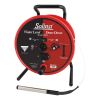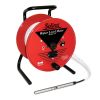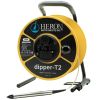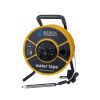Solinst Model 101 P7 Probe Water Level Meters
Features
- Probe is submersible to 1000 ft. for measuring total well depth
- Non-stretch PVDF well tape with stainless steel conductors
- Permanent laser markings every 1/100 ft. or each millimeter
- Free ground shipping
- Expedited repair and warranty service
- Lifetime technical support
- More
Overview
The Model 101 P7 Probe Water Level Meters are the industry standard for portable hand-operated meters to measure the depth of water in wells, boreholes, standpipes, and tanks. They are sturdy, easy to use, and read accurately up to 1/100 ft. or each millimeter. The Model 101 P7 Water Level Meter features a pressure-proof probe rated at 500 psi and laser-marked PVDF tape. The P7 Probe is submersible up to 1000 ft. (300 m), ideal for measuring total well depth. The sensor at the tip of the probe provides consistent measurements with almost zero displacements. The tape seal plug design allows the probe to be quickly and easily replaced if required.
Durability
The Model 101 P7 Probe Water Level Meter uses extremely durable PVDF flat tape, traceable to NIST and EU measurement standards. Each tape conductor contains 13 strands of stainless steel, and 6 strands of copper-coated steel, making the tape non-stretch and high in tensile strength and electrical efficiency. The well tape has a thick dog bone design that prevents adherence to wet surfaces and allows it to hang straight in application settings. The tape is also easy to splice. The 3/8" (10 mm) well tapes come with permanent laser markings every 1/100 ft. or each millimeter.
- (1) Solinst Model 101 P7 Probe Water Level Meter
- (1) Tape guide/datum
In The News
Wetland water level study skips modern sensor tangle for 1930s method
Environmental sensors can measure almost any physical parameter in nature, but sometimes they can overwhelm the science they are supposed to support. Jason Hill, an assistant professor of engineering at the University of Southern Indiana, wants to create a water level model that will help wetland restorers understand and predict water level fluctuations by studying water loss through the ground and evapotranspiration. The problem is his next project site has too many variables to measure. So, he’s taking an old fashioned route based on empiricism and water level measurement. Hill said that conventional techniques for estimating evapotranspiration require site specific micrometeorological data, like solar radiation, wind speed and vapor pressure.
Read MoreSource Water Monitoring in Albany, New York: Tracing Water Quality throughout Tributaries
Thousands of US cities pull their drinking water from natural source waters like reservoirs, rivers, and streams, making overall watershed health a key consideration for water providers. In Albany, New York, the Albany Department of Water and Water Supply delivers drinking water to over 100,000 residents as well as monitors and manages the larger drinking water supply watershed. Hannah Doherty, Environmental Specialist at the Albany Department of Water and Water Supply , spends her days working with a small team to monitor the drinking supply and the connected water bodies. Doherty explains, “We’re the first to encounter the water that ends up being the drinking water.
Read MoreWildfire Prevention in the Sierra Nevada Region with the Yuba Watershed Institute
Though recent wildfires have sparked new conversations about wildfire management and response, groups like the Yuba Watershed Institute have been monitoring the forests and water resources of the Sierra Nevada region for decades, managing approximately 5,000 acres of land with the Bureau of Land Management (BLM) and about 7,000 acres in private land partnerships. The goal of the Institute is to work with local communities and land agencies to improve watershed and forestry management through informed practices and public outreach. The goals of the Yuba Watershed Institute are three-fold: Improve the ability of fire suppression agencies like the California Department of Forestry and Fire Protection ( CAL FIRE ) and the US Forest Service.
Read More

































